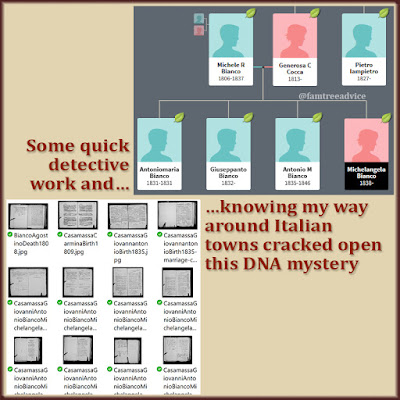Wouldn't it be great to have a safety net to catch all your forgotten source citations?
At times we all overlook adding sources to the family tree. When we start out, we don't know any better. Other times we forget or can't be bothered. These unsourced facts add up. And they make our online trees look less reliable.
There are a few reasons why facts in my family tree are missing a source citation:
- I never add a source for a person's sex. It seems unnecessary.
- I never add a source for an estimated birth year. If it's an estimate, there is no source. It's either 25 years before the birth of their eldest child or 25 years after the birth of their younger parent.
- Something happens to distract me in that moment.
- I experienced the fact (such as attending a wedding or funeral) but have no documentation.
- I'm in an excited rush because I just found all this great information, and I can hardly believe my luck!
Most of the time it's #5.
So, how do we find these unsourced facts before things get even more out of control? In a word: software.
It's easy to create an Undocumented Facts report in Family Tree Maker. Go to Publish / Source Reports / Undocumented Facts. I chose to share it as a CSV file. You can open a Comma-Separated Values file as a spreadsheet in a program such as Excel.
But there is a far better way to do this. This method has more steps, but it will save you so much time in the end.
 |
| Follow the steps to create a report and see where sources are missing. |
I've written many times about the free Family Tree Analyzer program. (Find all articles on the Genealogy Lessons page.) There are so many incredibly useful things to do with it. Now I find it's a great way to identify all your unsourced facts.
Here's how:
- Open your latest GEDCOM file with Family Tree Analyzer. (You can export a GEDCOM file from your family tree software, or download it from your online tree.)
- Click the Facts tab and check the boxes for all relationship types.
- Click the button to Select all Fact Types.
- Click the right arrow, which will duplicate the list of fact types.
- In this duplicate list, check the box for any fact types you don't want to include in this report. You should exclude facts that you know don't need a source. For example:
- Child Born. The baby gets a source for their birth date. The parent doesn't need a source for having had the kid.
- Custom facts. I have a custom Ahnentafel Number fact that doesn't need a source. If you have custom facts, you'll find them in this list in all capital letters.
- Click the big button that begins with "Show only the selected Facts for Individuals…."
Your report opens in a new window. At the top of that window, choose to export this report as an Excel file (actually a CSV file). Now open the file in your spreadsheet software.
First, sort the spreadsheet by the source column and delete the many, many rows of facts that DO have a source citation.
Next, delete the unnecessary columns to make things easier to see. I deleted all but Surname, Forenames, DateofBirth, TypeOfFact, FactDate, and Location.
 |
| Choose to export your report from Family Tree Analyzer to a spreadsheet. |
I'm left with an awful lot of rows of unsourced facts. But remember, I said I don't source estimated birth years. I can sort or filter the spreadsheet by the DateofBirth column and delete all the rows with "Abt" (short for About). That brings me down to a very manageable 133 rows of unsourced facts.
Finally, I'll sort the data by Surname so I can make my way through this task list. I'll delete a row once I've added the missing source citation to my family tree.
I know the complete dates from the 1800s fit into the category of "I'm in an excited rush." I have the documents to back up these dates. Now I need to go back and finish my work. I suspect some of the years (not full dates) in the 1900s will be birth years I took from a census sheet. Again, I need to finish my work.
It's nice to have this report as a safety net for days when you aren't on your best behavior. It's as if Family Tree Analyzer is your coach or teacher, reminding you to think about what you're doing. And by all means, show your work!














